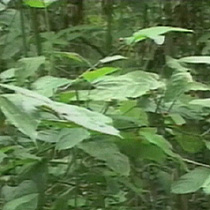-
(单词翻译:双击或拖选)
Kampala, Uganda
08 June 2007
In Uganda, there is widespread opposition1 over a proposal to allow part of the Mabira Forest Reserve to be clear-cut for sugar cane2 growing. Opponents say the move will destroy a delicate and unique African ecosystem3 and cause economic hardship to those who rely on the forest for their livelihoods4. Proponents5 argue that the plan will boost Uganda's economic and social development. Cathy Majtenyi recently visited Mabira Forest and files this report for VOA.
 |
| The Mabira Forest in Uganda |
First made a reserve in 1932, Mabira Forest has several important features. It is home to 30 percent of Uganda's birds, consisting of 315 species, including three globally-threatened ones such as the Nahan's Francolin.
The tropical rain forest contains 312 tree and shrub7 species, including Prunus Africana, which is used to treat prostrate8 cancer. There are also 23 species of small mammals.
Mabira Forest is a vital catchment area for Africa's largest fresh water body, Lake Victoria; Africa's longest river, the Nile; and other rivers and lakes that experts say serve thousands of people in the immediate9 area and millions downstream.
Ibrahim Senfuma is a nature guide at Mabira Forest. He says the diversity and uniqueness of the forest have helped him and his fellow Ugandans.
"I grew up not knowing how actually the inside of a hospital looks like," he said. "[When I] get malaria10, Mum goes to the bush, to the forest. At home we share a boundary [with Mabira Forest], so she could just move into the forest, come back with a few leaves, a few roots, and then malaria is gone,” he says. “Today, people who are bedridden with HIV/AIDS normally go to the forest [and] debark11 some trees, not killing12 them, but for medicine."
But what has Senfuma and others worried is a proposal by the Sugar Corporation of Uganda Limited to clear-cut 7,100 hectares of what the company says is degraded land on the forest's edges. The company is a joint13 venture of the India-based Mehta Group and the Ugandan government.
The sugarcane-growing operations cover 9,500 hectares near Mabira Forest. The company produces up to 50,000 tons of sugar per year and employs 6,000 people. The company says it needs the Mabira land to meet a projected sugar shortage of 170,000 tons a year in Uganda.
Suresh Sharma is regional director of African operations for the Mehta Group. He says the Mabira plan calls for employing 4,000 more people, and that his company in general has benefited Ugandans for the past 85 years.
"We provide employment to 6,000 people - 30,000 family members are living [on our estate]. We take care of all their medical requirements. We take care of their children's education,” says Sharma. “When the man who works for us retires, we employ his son or daughter. Besides this, we are also taking care of the environment by growing trees ourselves. In addition to that, we also distribute seedlings14 free of costs to the people around our areas."
But environmentalists and many local politicians say reducing the forest in any way will alter or destroy the whole forest's delicate ecosystem. And they also reject the company's economic arguments.
James Kunobwa-Kezaala is the speaker of the Mukono District Local Government. He says the company could help raise the living standards of many more residents of Mukono District by paying farmers directly for sugarcane grown on their farms rather than at the company's site.
"We have people already whom we have registered at the district, who number to 30,000 farmers. And if you take an estimate, each one maybe growing three acres per person -- three acres times 30,000 -- you have 90,000 acres of sugarcane ready by the people, not by the company,” he said.
Company regional director Sharma says he wrote to local government officials about hiring those farmers or procuring15 that land but did not receive a response.
There are also an estimated 20,000 people who directly or indirectly16 live off the forest.
Through agreements with the National Forestry17 Authority, individuals and groups such as the Mabira Forest Tendolye Women's Crafts and Farmers Group can go into certain areas of the forest and collect materials that they can use to make or process things. Members of the Tendolye Women's Group say they depend heavily on Mabira Forest to support their families.
Uganda has one of the highest deforestation rates in the world. Many Ugandans hope this trend does not continue in the widely-loved Mabira Forest as they wait for Uganda's parliament to vote on the proposed clear-cutting.
 收听单词发音
收听单词发音
1
opposition

|
|
| n.反对,敌对 | |
参考例句: |
|
|
|
2
cane

|
|
| n.手杖,细长的茎,藤条;v.以杖击,以藤编制的 | |
参考例句: |
|
|
|
3
ecosystem

|
|
| n.生态系统 | |
参考例句: |
|
|
|
4
livelihoods

|
|
| 生计,谋生之道( livelihood的名词复数 ) | |
参考例句: |
|
|
|
5
proponents

|
|
| n.(某事业、理论等的)支持者,拥护者( proponent的名词复数 ) | |
参考例句: |
|
|
|
6
controversy

|
|
| n.争论,辩论,争吵 | |
参考例句: |
|
|
|
7
shrub

|
|
| n.灌木,灌木丛 | |
参考例句: |
|
|
|
8
prostrate

|
|
| v.拜倒,平卧,衰竭;adj.拜倒的,平卧的,衰竭的 | |
参考例句: |
|
|
|
9
immediate

|
|
| adj.立即的;直接的,最接近的;紧靠的 | |
参考例句: |
|
|
|
10
malaria

|
|
| n.疟疾 | |
参考例句: |
|
|
|
11
debark

|
|
| v.卸载;下船,下飞机,下车 | |
参考例句: |
|
|
|
12
killing

|
|
| n.巨额利润;突然赚大钱,发大财 | |
参考例句: |
|
|
|
13
joint

|
|
| adj.联合的,共同的;n.关节,接合处;v.连接,贴合 | |
参考例句: |
|
|
|
14
seedlings

|
|
| n.刚出芽的幼苗( seedling的名词复数 ) | |
参考例句: |
|
|
|
15
procuring

|
|
| v.(努力)取得, (设法)获得( procure的现在分词 );拉皮条 | |
参考例句: |
|
|
|
16
indirectly

|
|
| adv.间接地,不直接了当地 | |
参考例句: |
|
|
|
17
forestry

|
|
| n.森林学;林业 | |
参考例句: |
|
|
|















